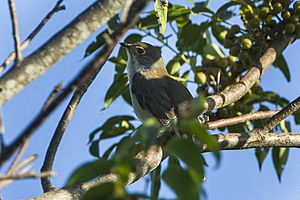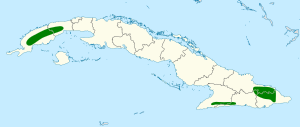Cuban solitaire facts for kids
The Cuban solitaire (Myadestes elisabeth), also known as the Cuban nightingale, is a special kind of bird. It belongs to the Turdidae family, which includes birds like thrushes. This bird is endemic to Cuba, meaning it lives only there and nowhere else in the world.
The Cuban solitaire makes its home in the cool, wet mountain forests of Cuba. Sadly, its home is shrinking because of habitat loss, which means its natural forest environment is being destroyed.
Quick facts for kids Cuban solitaire |
|
|---|---|
 |
|
| Conservation status | |
| Scientific classification | |
| Genus: |
Myadestes
|
| Species: |
elisabeth
|
 |
|
Contents
About the Cuban Solitaire
The Cuban solitaire is a small, shy bird. It is famous for its beautiful and complex song. Many people consider its song to be one of the prettiest sounds in the Cuban forests. This is why it is often called the "Cuban nightingale."
What it Looks Like
While the text does not describe its exact colors, most solitaires are small to medium-sized birds. They often have soft, muted colors like gray, brown, or olive green. This helps them blend in with the forest environment.
Its Amazing Song
The Cuban solitaire's song is truly special. It is a mix of clear, flute-like whistles and musical trills. The bird often sings early in the morning or late in the afternoon. Its song helps it find a mate and mark its territory in the dense forest.
Where the Cuban Solitaire Lives
This unique bird lives only on the island of Cuba. It prefers the high, moist mountain forests. These forests are rich in tall trees, thick plants, and plenty of insects for the bird to eat. The cool, damp air in these mountains is perfect for its survival.
Its Natural Home
The Cuban solitaire needs specific conditions to thrive. It lives in the upper parts of the mountains, where the forests are often misty and full of life. These areas provide the bird with food, shelter, and safe places to build its nest.
Why the Cuban Solitaire Needs Our Help
The biggest threat to the Cuban solitaire is habitat loss. This means that the forests where it lives are being cut down or changed by human activities. When forests are destroyed, the birds lose their homes, food sources, and places to raise their young.
Protecting Its Home
Protecting the Cuban solitaire means protecting its forest home. Conservation efforts are important to make sure these special birds continue to sing in the Cuban mountains for many years to come. This includes setting up protected areas and educating people about the importance of forests.
Discovery and Naming
The Cuban solitaire was first officially described in 1850. It was named by a scientist named Juan Lembeye. The scientific name, Myadestes elisabeth, helps scientists around the world identify this specific bird.
See also
 In Spanish: Ruiseñor para niños
In Spanish: Ruiseñor para niños


